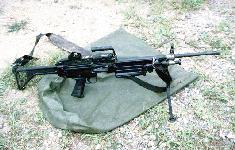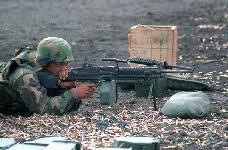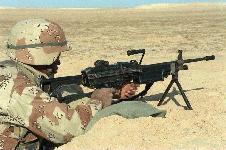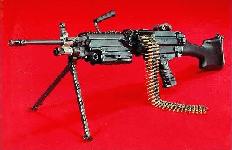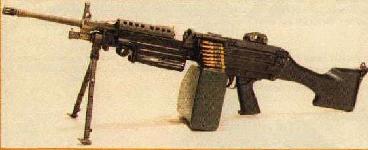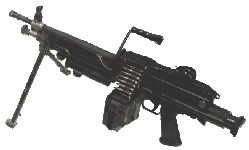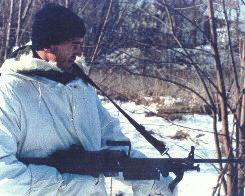 The automatic rifle is a squad leaders weapon.
Though the automatic rifle has changed, the role of the automatic rifleman has not since its conception circa World War I. The automatic rifleman supports the infantry squad in the offense and defense. The M249 SAWS is a lightweight, gas-operated, magazine or disintegrating metallic link-belt fed, individually portable machine gun capable of delivering a large volume of effective fire. The M249 AR provides accurate fire approaching that of the rifle yet gives the heavy volume of fire common to a machine gun. The M249 replaces the two automatic M16A1 rifles in the rifle squad on a one-for-one basis in all infantry type units and in other units requiring high firepower. Fielded in the mid-1980s, the SAWS filled the void created by the retirement of the Browning Automatic Rifle (BAR) during the 1950s because interim automatic weapons (M14 Series/M16A1 Rifles) had failed as viable "base of fire" weapons.
The Squad Automatic Weapon (SAW) is an air-cooled, belt-fed, gas-operated automatic weapon that fires from the open-bolt position. It has a regulator for selecting either normal (750 rounds per minute [rpm)) or maximum (1,000 rpm) rate of fire. The maximum rate of fire is authorized only if the weapon's firing rate slows under adverse conditions. Although the M249 AR is primarily used as an automatic rifle, it is also used as a light machine gun. It can be fired from the shoulder, hip, or underarm position; or from the bipod-steadied position. When employed as a machine gun, it has a tripod with a T&E mechanism and a spare barrel; however, barrels must not be interchanged with those from other M249s unless the headspace has been set for that weapon by direct support personnel.
The automatic rifle is a squad leaders weapon.
Though the automatic rifle has changed, the role of the automatic rifleman has not since its conception circa World War I. The automatic rifleman supports the infantry squad in the offense and defense. The M249 SAWS is a lightweight, gas-operated, magazine or disintegrating metallic link-belt fed, individually portable machine gun capable of delivering a large volume of effective fire. The M249 AR provides accurate fire approaching that of the rifle yet gives the heavy volume of fire common to a machine gun. The M249 replaces the two automatic M16A1 rifles in the rifle squad on a one-for-one basis in all infantry type units and in other units requiring high firepower. Fielded in the mid-1980s, the SAWS filled the void created by the retirement of the Browning Automatic Rifle (BAR) during the 1950s because interim automatic weapons (M14 Series/M16A1 Rifles) had failed as viable "base of fire" weapons.
The Squad Automatic Weapon (SAW) is an air-cooled, belt-fed, gas-operated automatic weapon that fires from the open-bolt position. It has a regulator for selecting either normal (750 rounds per minute [rpm)) or maximum (1,000 rpm) rate of fire. The maximum rate of fire is authorized only if the weapon's firing rate slows under adverse conditions. Although the M249 AR is primarily used as an automatic rifle, it is also used as a light machine gun. It can be fired from the shoulder, hip, or underarm position; or from the bipod-steadied position. When employed as a machine gun, it has a tripod with a T&E mechanism and a spare barrel; however, barrels must not be interchanged with those from other M249s unless the headspace has been set for that weapon by direct support personnel.
The M249 is interesting because while its standard ammunition feed is by 200 round disintegrating belts, it is also capable of firing ammunition from standard M16 magazines inserted in a magazine well in the bottom of the SAW. Ammunition is fed into the weapon from a 200-round ammunition box holding a disintegrating metallic split-link belt. The SAW also has an alternating feeding method using 20- and 30-round M16 rifle magazines. The weapon has a quick-change barrel; however, barrels must not be interchanged with those from other SAWs unless their headspace has been set for that weapon by direct support personnel. The M249 SAW is used to engage dismounted infantry, crew-served weapons, antitank guided missile (ATOM) teams, and thin-skinned vehicles. The SAW has become the standard automatic rifle of the infantry squad and has proven useful with the changing of the M16 to a three round burst weapon.
Automatic rifles allow rifle squads to take a light automatic weapon with them in the assault. In the defense, they add the firepower of 10 or 20 riflemen without the addition of manpower. Characteristically, automatic rifles are light, fire rapidly, and have more ammunition than the rifles in the squad that they support. Each squad has three automatic rifles. No additional equipment configuration is needed, because the automatic rifleman fires the M249 either from the bipod mode or from various hand-held positions. In either the offense or defense, automatic riflemen must restrict themselves to firing three-round bursts to maintain their effectiveness against enemy targets. The M249 in the bipod or hand-held mode moves too easily off its point of aim after three rounds and automatic riflemen must readjust their aim. In the offense, the automatic rifleman is limited to what he can carry and fire on the move. Hence, while the automatic rifle affords a high volume of fire, it also rapidly consumes ammunition. Conservation and careful logistic planning become important. When used as a machine gun, the M249 requires a tripod, a T&E mechanism, and a spare barrel. These items increases the stability, the ability to make minute adjustments in aiming, and the ability to fire greater than three-round bursts. Because machine guns are not as mobile as automatic rifles, they normally remain with and form the key weapon of the base-of-fire element. It is possible to bring a machine gun with the maneuver element for added firepower in the assault. But once it has set up, it becomes another base of fire and is quickly left behind by the rest of the element as it sweeps across the objective. It will spend more time displacing than firing. Machine guns target enemy automatic weapons, key weapons, and command and control elements. Once the enemy deploys, machine guns engage his supporting automatic weapons. As the enemy closes, if the machine guns have destroyed all of the enemy's supporting weapons, they can engage the assaulting troops with enfilading fires across the platoon front. Primary function: Hand-held combat machine gunManufacturer: Fabrique Nationale Manufacturing, Inc.
Length: 40.87 inches (103.81 centimeters)
Weight:
With bipod and tools: 15.16 pounds (6.88 kilograms)
200-round box magazine: 6.92 pounds (3.14 kilograms)
30-round magazine: 1.07 pounds (.49 kilograms)
Bore diameter: 5.56mm (.233 inches)
Maximum effective range: 3281 feet (1000 meters) for an area target
Maximum range: 2.23 miles (3.6 kilometers)
Rates of fire:
Cyclic: 725 rounds per minute
Sustained: 85 rounds per minute
Unit Replacement Cost: $4,087
Features: The Squad Automatic Weapon (SAW), or 5.56mm M249 is an individually portable, gas operated, magazine or disintegrating metallic link-belt fed, light machine gun with fixed headspace and quick change barrel feature. The M249 engages point targets out to 800 meters, firing the improved NATO standard 5.56mm cartridge.
The SAW forms the basis of firepower for the fire team. The gunner has the option of using 30-round M16 magazines or linked ammunition from pre-loaded 200-round plastic magazines. The gunner's basic load is 600 rounds of linked ammunition.
Background: The SAW was developed through an initially Army-led research and development effort and eventually a Joint NDO program in the late 1970s/early 1980s to restore sustained and accurate automatic weapons fire to the fire team and squad. When actually fielded in the mid-1980s, the SAW was issued as a one-for-one replacement for the designated "automatic rifle" (M16A1) in the Fire Team. In this regard, the SAW filled the void created by the retirement of the Browning Automatic Rifle (BAR) during the 1950s because interim automatic weapons (e.g. M-14E2/M16A1) had failed as viable "base of fire" weapons. Early in the SAW's fielding, the Army identified the need for a Product Improvement Program (PIP) to enhance the weapon. This effort resulted in a "PIP kit" which modifies the barrel, handguard, stock, pistol grip, buffer, and sights.
AMMUNITION
The preferred combat ammunition mix for the M249 is a four-ball (M855) and one-tracer (M856) mix. There are other variations of 5.56-mm ammunition available; however, the four-and-one mix allows the gunner to use the tracer-on-target (TOT) method of adjusting fire to achieve target kill.
| Type
M855 Ball M193 Ball M856 Tracer M196 Tracer M199 Dummy M200 Blank |
Use
Against light materiel targets and personnel. Range training. Observation of fire, incendiary effects, and signaling. Training. During mechanical training. During training when simulated live fire is desired. (A blank firing attachment must be used to fire this ammunition.) |



